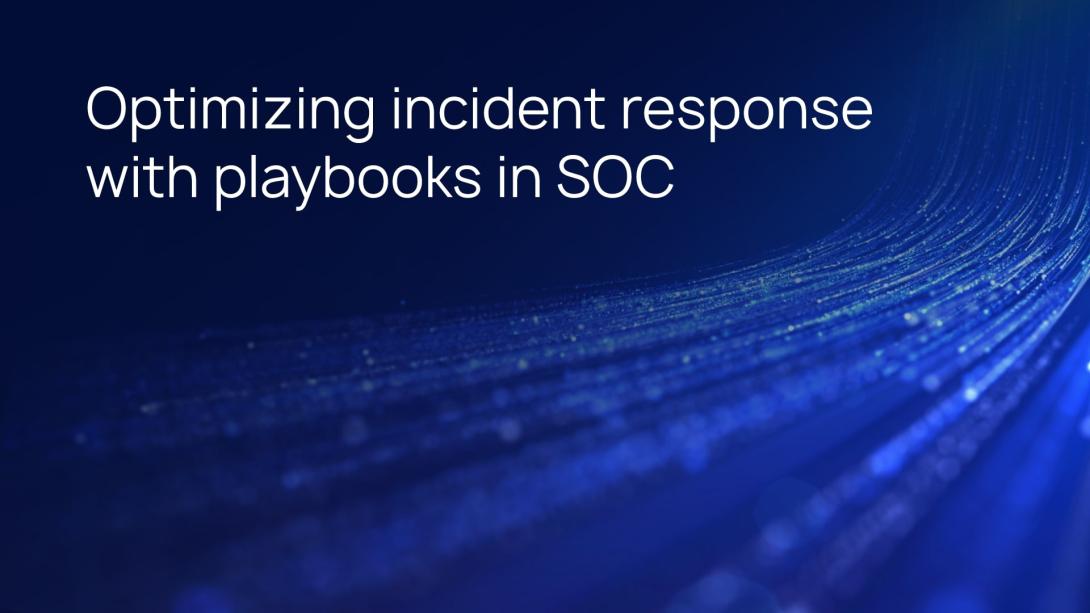09/04/2025

By Konstantin Karasev, Lead Cybersecurity Architect
Playbooks in Security Operation Centers: what should they be like?
Any cybersecurity center, regardless of its maturity level, deals with a range of routine operations primarily focused on monitoring, incident response (i.e., taking actions to minimize damage from an incident), and reporting to optimize and improve SOC operations.
Sooner or later, the number of operations increases, making it necessary to automate certain routine tasks. Despite powerful AI-based tools, cybersecurity centers still need human involvement. However, it is important to note that additional automation tools do lower the threshold for entry into SOC analyst work, leading to cost savings. Any cybersecurity center is interested in spending money wisely and generally protecting the company's revenue, in whose interests the SOC operates.
What is a playbook?
Essentially, a playbook is a set of actions designed to achieve a specific result, it’s not necessarily identical to a response scenario. Customers of automation systems sometimes confuse response scenarios with playbooks, assuming they are the same. However, this is not entirely true.
A response scenario is a structured sequence of actions carried out during an incident's lifecycle. It must be well-developed, approved by all relevant stakeholders, and tested in advance to ensure readiness before a real incident occurs. Not every scenario can be fully automated, which is why analysts often perform certain actions manually based on scenario outcomes. Depending on these results, specific playbooks should be triggered.
In other words, a playbook is a set of automated actions executed as part of a response scenario. It is important to note that playbooks designed for equipment inventory are not considered part of response scenarios. In this article, we focus specifically on playbooks that support incident response scenarios.
A playbook with only two actions is still a playbook. A playbook with 100 actions and multiple filters is also a playbook. Regardless of its complexity, if it solves a specific task, it is a well-designed playbook. An improper playbook consists of useless actions that don`t help analyst or any other employee achieve their goals more quickly. Creating playbooks only to demonstrate a high level of automation is a poor practice. Even a small number of well-designed playbooks can significantly enhance SOC operations. Each playbook should have a specific result, whether it is gathering information, isolating a threat, blocking an IP address, or escalating an incident. Vague, overly complex, or poorly structured playbooks can hinder SOC efficiency rather than improve it.
All playbooks should be adapted to the specific needs of an organization, even if they are based on out-of-the-box SOAR solutions. They must take into account organizational structure, internal policies, established processes, and practical considerations. Each playbook should have a well-defined sequence of actions with clear transition conditions between steps, ensuring their logical execution.
In some cases, a playbook may fail due to factors such as network unavailability, high server load, or long execution queues. In these situations, SOC analysts must be prepared to perform necessary actions manually.
Each playbook must have a properly defined trigger for activation. In our experience, we have encountered playbooks that were executed unnecessarily, placing an additional load on the system.
It is crucial to apply filtering and provide analysts with only the essential information. Overloading analysts with excessive data can reduce their work efficiency. For example, when analyzing an attack artifact in the form of a hash value, VirusTotal can return a massive JSON file. While filtering unnecessary details is helpful, the raw data should still be preserved for investigation purposes. All original files should be stored as part of the incident evidence.
Types of playbooks
If you are new to playbooks and considering automation, playbooks can generally be divided into the following types:
Operational (routine) playbooks automate routine processes tasks such as collecting incident information, verifying the reputation of IP addresses and domains, and analyzing email attachments.
Threat response (active response) playbooks minimize the impact of security incidents by blocking accounts, isolating infected nodes, and adding IP addresses to blacklists.
Forensics and investigation playbooks automate the collection and analysis of artifacts, correlate events, and identify attack sources.
Notification and escalation playbooks notify responsible personnel, escalate incidents based on severity level, and provide periodic investigation updates to stakeholders.
How are playbooks created?
The first step in developing playbooks is analyzing SOC processes to determine which tasks can be automated and which require human intervention. Before implementing automation, organizations must establish clear response scenarios and define the corresponding actions to be automated.
Playbooks should be created in collaboration with SOC analysts who will use them. This approach ensures that playbooks meet practical needs while avoiding excessive or insufficient automation. It is also important to avoid over-automation, as some tasks require contextual analysis and decision-making that cannot be predefined.
Playbooks must undergo continuous testing and improvement. They should be regularly reviewed as threats and technologies change, their effectiveness and relevance must be constantly evaluated.